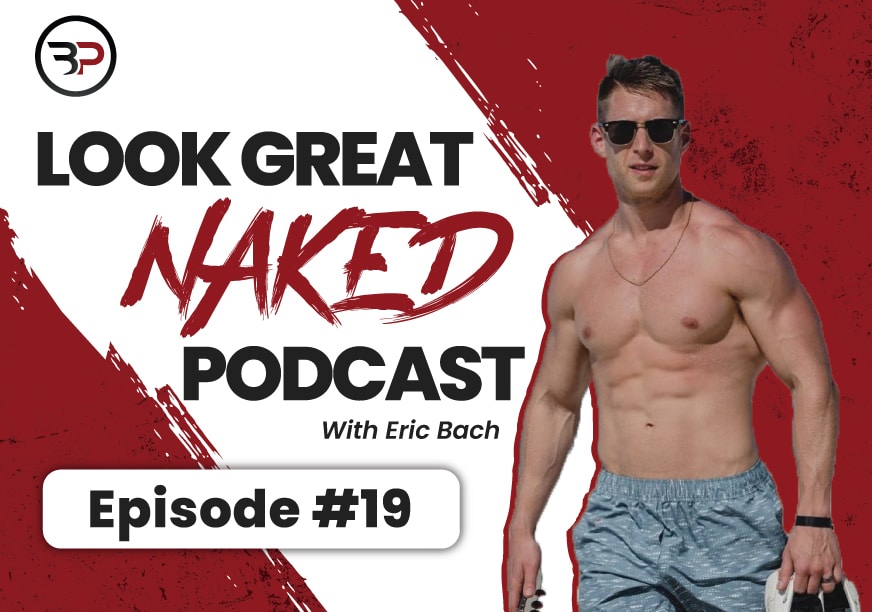How To Build Sleek, Washboard Abs (3-D Core Training, Part 3)
May 29, 2018
Preventing annoying back pain and having a strong powerful core is great, but let’s cut to the chase.
What you really want is to lose the annoying flab hangin’ over your summer shorts to reveal a strong, defined core.
And what you really, really want is Hollywood-style washboard abs.
In both cases, today is your lucky day. You’re going to learn the step-by-step process to getting rid of your gut and the best exercises to carve your core for washboard abs.
Step One: Read the first two parts of the 3-D core training series. If you skip these steps, you won’t be ready for part three (today, bruh) without a much bigger chance of injury.
Read part one here and part two here.
Step Two: Lose Fat. Sorry, but the six pack just ain’t happening if excess body fat is still happening.
Step Three: Intelligent abs training to build muscle tissue for deeper ab separation and better definition.
Flat Abs Fat Loss Diet
As the saying goes, “abs are made in the kitchen, not the gym. “ This is true. You need to be lean enough to have visible abs.
Men will start to see the outline of their abs around 12% body fat, while women will notice definition when around 17-18% body fat.
And those cover models with defined, V-cut abs? I outline the whole process here but they’re closer to 5% body fat for men and 14% for women. The lower your body fat gets, the deeper the cuts and the more prominent your v-line, chiseled abs become.
At the most basic level, creating a caloric deficit is the most important aspect of fat loss.
No, you can’t really spot reduce and only lose the fat hanging around your belly like a stage five clinger.
But what you can do?
You can spot enhance, or build lean muscle tissue, through your entire body. You’ll make your abs more prominent even at higher body fat levels. But first, you need to ensure a caloric deficit.
Calorie Deficit Macros
Fat loss diets are confusing enough and there’s no need to make them worse. Follow these simple guidelines.
Overall Calories
There are dozens of complicated equations to determine the calories you need to lose fat. They’re all estimations and I’ve found bodyweight (lbs) x10-12 to be as accurate as any of them.
This will give you a range of calories to eat each day. Both of these will put you in a caloric deficit. If you want to be more aggressive, shoot for the bodyweight (lbs) x10. Otherwise, you can do bodyweight x10 on non-lifting days and bodyweight x12 on lifting days. You should lose fat in both cases.
200 lbs x10= 2000 on off-days
200lbs x12= 2400 on lifting days
Caloric Range: 2000-2400.
As a side note, if you’re significantly overweight or have been unsuccessfully dieting long-term, you’ll need a more customized approach, like those used in our coaching program. In these cases, your hormones are likely out of whack. You’ll need to reverse diet or seek special treatment from a medical professional, such as an endocrinologist or registered dietician.
Protein
Shoot for 1 gram of protein per pound of bodyweight. Protein helps you preserve lean muscle, which keeps your metabolism running full throttle so you look lean, jacked, and defined…not scrawny and soft after a diet.
200 lbs x1g/1lb/bw= 200g protein, or 800 calories.

Carbs
Carbs are not “the devil” when it comes to fat loss.
Low-carb diets can work well for some people because reducing carbs (mainly refined sugars and flour) also leads to eating fewer calories and more veggies.
Voila. This leads to fat loss.
But wait. It gets better. These folks also see an immediate drop in the scale due to the “flushing” effect of a low carb diet. It builds momentum and compliance to a fat loss diet.
I find most folks do best when eating 35% of their calories from carbs like potatoes, squash, fruits, and vegetables.
2000 Calories x.35= 700 calories /4 calories/gram = 175g
2400 calories x.35= 840 calories/4 = 210g
Fat
The remainder of your calories should be from fat. To do that, we’ll take the total number of calories and subtract the calories from protein and carbs.
2000 calories-800 calories (200g protein) -700 calories (175g carbs)=
2400 Calories -800 calories (200g protein) -840 calories (210g carbs)= 760 calories/9 cals/g= 84g of fat
Try creating your own macros, or save the headspace, apply for coaching, and I’ll guide you step-by-step to building your best body.
A Quick Shot Of Fat Loss Reality
Despite what Instagram might say, you can only lose fat so fast. #Sorry!
The truth is you can only lose 1-2% of your bodyweight per week. The more weight you have to lose, the faster you’ll lose it. The leaner you are? The slower the process.
As a working example, someone who weighs 300 pounds might lose six pounds in a week, whereas someone who weighs 200 pounds may lose two pounds.
In both cases, we’ve been force-fed lies by #evilfitnessmarketingBS that fat loss is a fast process. The truth is, it takes time. In many cases, the slower and more sustainable approach wins out because you’ll develop the habits needed to KEEP the weight off.
Bottom line? Give yourself plenty of time and stay consistent. The weight will come off if you stick to the plan.
Next? You Need to Build Muscular Abs
As Christian Thibadeau points out in a recent T-nation article, having that six pack is dependent both on having a thinner layer of fat and having separation between the sections of the “pack.”
That separation occurs when the muscle bellies of your abs are thicker than the tendinous attachments (the lines between the abs). Since the muscle bellies can get thicker if you train them, but not the attachments, training can give you that separation you need.”
Translation?
The more muscular your abs, the deeper the cuts and the more definition you’ll reveal at higher body fats.
Please stop doing thousands of sit-ups in the faint hope they will lead to a toned stomach.
Focus on preventing injuries and building performance before simply trying to crunch your way to a six-pack.
Be patient. Trust the process. You will wind up with a core that feels, performs, and yes, looks good…naked.

The Washboard Abs Workout
Your abs are like any other muscle
In order to grow you need:
* Load and time under tension (heavy load)
* metabolic stress (the “burn” you get during crunches)
* and muscular damage (the microtears in muscle tissue so that they come back stronger)
Here’s what you need to do.
First, lift heavy three to four times per week with compound movements. These big movements like squats, rows, and deadlifts build strength from head to toe. They also stimulate your abs, even if it doesn’t feel like they’re working.
Second, do the “anti-movements” in your training to build a strong, stable and injury-resistant core. You can take care of that by doing this simple warm up.
Third, we’ll hone in on specific abs exercises to create the deep, dense muscle needed for head-turning washboard abs.
Five Exercises To Build Washboard Abs
1. Hollow Body Hold
A gymnastics move by nature, the hollow body hold teaches you to brace and hold neutral spine while contracting your entire rectus abdominis muscle. Lie flat on the ground, looking up. Flatten your lower back and flex your knees, pointing your toes away from you. Straighten your legs while you lift your arms so that they’re perpendicular to your torso. Keep your back flat on the floor and lift your head and shoulders off the ground. Aim to do these twice a week.
2. Hanging Leg Raise
The hanging leg raise is a popular exercise for targeting your lower abs. By keeping your elbows slightly bent and shoulders retracted (i.e. held down and in, rather than creeping up toward your ears) you’ll also stretch the lats. Bonus: you’ll build a stronger grip, and develop more muscular forearms.
Grab a pull-up bar with a double overhand grip, squeezing the bar as tight as possible and keeping the elbows slightly bent. Retract your shoulders, as if tucking them into your back pocket and holding them there.
From this position, lift your legs up just past 90 degrees, forming an L shape with your body. Pause at the top for two seconds, then lower with control. Too tough? Then try them with your knees bent, lifting and holding for 5-10 seconds if possible.
If you struggle to hold on to the bar, feel free to use the Roman chair version in which you’re supported by your elbows and upper body.
3. Stability Ball Rollout
Stability ball rollouts are a great way to build strong abs while preparing your body for a greater challenge: the ab wheel rollout.
To start, kneel on the floor (it may be helpful to place an Airex pad or yoga mat beneath your knees) and face a stability ball with your arms extended in front of your body. Your hands should sit atop the ball. Brace your abs to prevent your back from arching, lean forward, and roll your arms over the ball as far as possible so that your entire torso lowers toward the floor. Then reverse the motion and pull your arms and torso back until you return to the starting position.
By Tony Gentilcore:
4. Ab Wheel Rollout
Ab wheel rollouts are an absolute killer for building strong, dense abs. Beyond building muscle, they force you to resist unwanted extension in the lower back.
Kneel down and hold the handles of the wheel with your arms locked out beneath your shoulders. Brace your abs and roll the wheel as far forward as possible without shifting your hips or arching your lower back, then roll back.
<a href="https://www.youtube.com/watch?v=7K-bK0RhhOU">
5. Cable Crunch
Remember the days when crunches and situps were all the rage? Consider this the leader of the pack when it comes to crunching exercises. Just like any exercise, progressive overload (adding weight) can help you build stronger abs that pop.
Kneel facing the pulley and hold the ends of a rope attached to the high cable along the sides of your face. Bend forward, aiming your chest at your pelvis. Return to the starting position, then repeat the movement.
Here’s how it looks when you put all of those exercises together into a single workout.
Sample Abs Workout Routine
Perform this sample routine two times per week for four weeks at the end of two of your regular weight lifting workouts.
- Ab wheel rollout OR stability ball rollout, 2 sets x 8-12 reps, rest 90 seconds
- Hollow Body Hold 3 sets x 45 seconds, rest 45 seconds.
- Hanging Leg Raise 3 sets x 12-15 reps, rest 45 seconds.
- Cable Crunch 3 sets x 15 reps, rest 45 seconds
The Takeaways
- Build show-worthy abs by adding direct ab training while also continuing to develop the core’s ability to prevent unwanted movement
- Follow a gradual approach to fat loss that helps you reveal your hard work to the world with a lean, defined midsection.
- Above all else, you need a well-balanced training approach to build your best looking and best performing body.
A well-balanced training approach like the one found right here in the Power Primer 2.0. Get yours today and move one step closer to the body you are looking for.









